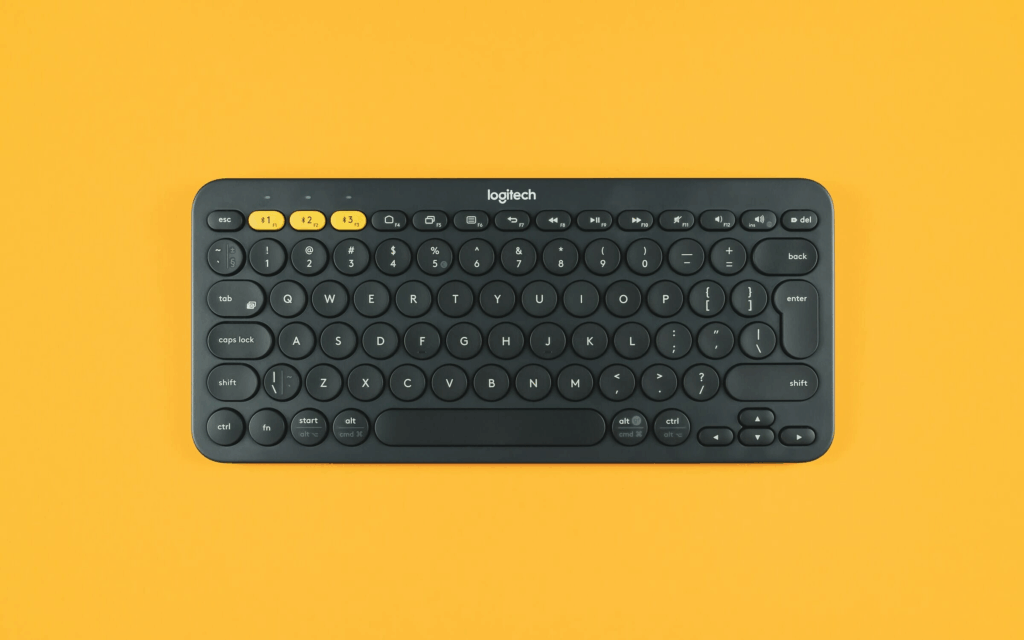When your logitech keyboard not connecting to your computer, it can ruin your whole day. You sit down to work or play games, and nothing happens when you type. The cursor just sits there, mocking you.
Don’t worry – this problem is super common. Most keyboard connection issues have simple fixes. You don’t need to be a tech expert to solve them.
In this guide, we’ll walk through every solution step by step. By the end, your keyboard will be working again.

Quick Checks Before You Start Troubleshooting
Before diving into complex fixes, let’s check the obvious stuff first. These simple steps solve about 50% of keyboard problems.
Check Your USB Connection
Look at where your keyboard plugs into your computer. Is the USB cable pushed all the way in? Sometimes it looks connected but isn’t quite right.
Try unplugging it and plugging it back in. Push firmly until you hear a click or feel it lock in place.
Also, try a different USB port. Sometimes one port stops working while others work fine.
Look for Physical Damage
Check your keyboard cable for any obvious damage. Look for:
- Bent or broken connectors
- Cuts or kinks in the cable
- Loose connections where the cable meets the keyboard
If you see damage, that’s probably your problem. You might need a new cable or keyboard.
Test on Another Computer
If you have access to another computer, try your keyboard there. This tells you if the problem is with your keyboard or your computer.
If it works on another computer, the issue is with your main computer. If it doesn’t work anywhere, your keyboard might be broken.
Logitech Keyboard Not Connecting: Wireless Issues
Wireless keyboards have their own special problems. The good news is that most wireless connection issues are easy to fix.
Check Your Batteries
Dead batteries are the most common reason wireless keyboards stop working. Even if your keyboard worked yesterday, batteries can die suddenly.
Replace the batteries with fresh ones. Don’t use old batteries from a drawer – get new ones from the store.
Some Logitech keyboards have battery indicators. Look for a light that shows battery status.
Re-pair Your Keyboard
Sometimes wireless keyboards “forget” their connection to your computer. You need to pair them again.
Here’s how to do it:
- Turn off your keyboard
- Unplug the USB receiver from your computer
- Wait 10 seconds
- Plug the receiver back in
- Turn on your keyboard
- Press the connect button on both the receiver and keyboard
The connect button is usually small and might need a paperclip to press.
Check for Interference
Other wireless devices can mess with your keyboard’s signal. This includes:
- WiFi routers
- Cell phones
- Other wireless keyboards or mice
- Microwave ovens (when running)
Try moving your keyboard closer to the receiver. Also, move other wireless devices away from your computer.
Driver Problems and Solutions
Your computer needs special software called drivers to talk to your keyboard. When drivers get messed up, your keyboard stops working.
Update Your Keyboard Drivers
Windows usually handles drivers automatically, but sometimes it needs help. Here’s how to update them:
Press Windows key + X and click “Device Manager”. Look for “Keyboards” in the list and click the arrow next to it.
Find your Logitech keyboard in the list. Right-click on it and choose “Update driver”.
Click “Search automatically for drivers” and let Windows do its thing.
Uninstall and Reinstall Drivers
If updating doesn’t work, try removing the driver completely and starting fresh:
- Go back to Device Manager
- Right-click your keyboard
- Choose “Uninstall device”
- Unplug your keyboard
- Restart your computer
- Plug your keyboard back in
Windows will automatically install a fresh driver when you plug the keyboard back in.
Download Logitech Software
Logitech makes special software for their keyboards. This software often works better than Windows’ generic drivers.
Go to Logitech’s website and search for your keyboard model. Download and install their official software.
This software also lets you customize your keyboard settings and test if all keys work properly. Speaking of testing, you might want to use a keyboard tester to check if your keys are responding correctly after you get things working again.
Windows-Specific Fixes
Sometimes Windows itself causes keyboard problems. These fixes target common Windows issues.
Run the Keyboard Troubleshooter
Windows has a built-in tool to fix keyboard problems. Here’s how to use it:
- Press Windows key + I to open Settings
- Click “Update & Security”
- Click “Troubleshoot” on the left side
- Click “Additional troubleshooters”
- Find “Keyboard” and click “Run the troubleshooter”
Follow the instructions on screen. The troubleshooter will try to find and fix problems automatically.
Check Windows Updates
Sometimes a Windows update fixes keyboard problems. Other times, an update causes them.
Go to Settings > Update & Security > Windows Update. Click “Check for updates” and install any available updates.
If your keyboard stopped working right after an update, you might need to roll back that update.
Restart Windows Services
Windows runs background services that handle keyboard input. Sometimes these services get stuck.
Press Windows key + R, type “services.msc” and press Enter.
Look for “Human Interface Device Service” in the list. Right-click it and choose “Restart”.
Also restart “Windows Audio” service if you see it.
Advanced Troubleshooting Steps
If basic fixes don’t work, let’s try some more advanced solutions. Don’t worry – we’ll keep the steps simple.
Check BIOS Settings
Your computer’s BIOS controls basic hardware functions. Sometimes keyboard settings get changed there.
Restart your computer and press F2, F12, or Delete during startup (the exact key depends on your computer).
Look for USB or keyboard settings. Make sure USB ports are enabled and legacy USB support is turned on.
Save changes and exit BIOS.
Try Safe Mode
Safe Mode loads Windows with only basic drivers. If your keyboard works in Safe Mode, you know the problem is software-related.
To get to Safe Mode:
- Hold Shift while clicking the Restart button
- Choose “Troubleshoot”
- Choose “Advanced options”
- Choose “Startup Settings”
- Click “Restart”
- Press 4 to start in Safe Mode
Test your keyboard in Safe Mode. If it works, you have a software problem to fix.
Clean Boot
A clean boot starts Windows with minimal programs running. This helps identify if another program is causing the problem.
Press Windows key + R, type “msconfig” and press Enter.
On the General tab, choose “Selective startup” and uncheck “Load startup items”.
Click OK and restart your computer. Test your keyboard.
Hardware Issues and When to Replace
Sometimes keyboards just break. Here’s how to tell if yours is beyond repair.
Signs Your Keyboard Is Dying
Look for these warning signs:
- Some keys work, others don’t
- Keys stick or feel mushy
- Random characters appear when you type
- The keyboard works sometimes but not others
If you notice these problems getting worse over time, your keyboard is probably failing.
Testing Key Functionality
When your keyboard starts working again, it’s smart to test all the keys. A keyboard tester tool can help you check every key quickly to make sure they all respond properly.
This is especially important if you use your keyboard for work or gaming where every key needs to work perfectly.
When to Buy a New Keyboard
Consider replacing your keyboard if:
- It’s more than 5 years old
- Fixing it costs more than a new one
- Multiple keys don’t work
- The connection problem keeps coming back
Modern keyboards are pretty affordable, and a new one might have better features anyway.
Prevention Tips for Future Problems
Once you get your keyboard working, here’s how to keep it that way.
Keep It Clean
Dust and crumbs are keyboards’ worst enemies. Clean your keyboard regularly with:
- Compressed air to blow out dust
- Slightly damp cloth for the surface
- Cotton swabs for tight spaces
Never use water directly on your keyboard. Always unplug it before cleaning.
Handle Cables Carefully
Don’t yank on keyboard cables or bend them sharply. When you move your setup, coil cables loosely.
Avoid running cables under chair wheels or through tight spaces where they might get pinched.
Update Software Regularly
Keep your computer and keyboard software up to date. Set Windows to install updates automatically.
Check Logitech’s website occasionally for new software versions for your specific keyboard model.
Getting Help from Logitech Support
If nothing works, Logitech’s support team can help. They know their products better than anyone.
Before You Contact Support
Gather this information first:
- Your exact keyboard model number
- When you bought it
- What troubleshooting steps you’ve already tried
- Your computer’s operating system
This information helps support give you better help faster.
Warranty Coverage
Most Logitech keyboards come with at least a 1-year warranty. If your keyboard is still under warranty and nothing fixes it, you might get a free replacement.
Keep your receipt or order confirmation as proof of purchase.
Why Understanding Your Keyboard Matters
Learning about keyboard problems helps you in the long run. When you understand how keyboards work, you can fix issues faster next time.
Different keyboards have different layouts and features. Understanding keyboard layouts can help you choose better keyboards in the future and use them more effectively.
This knowledge is especially useful if you use keyboard shortcuts regularly, like keyboard shortcuts for video calls or other productivity tasks.
Final Thoughts on Logitech Keyboard Connection Issues
A logitech keyboard not connecting doesn’t have to ruin your day. Most connection problems have simple solutions that you can do yourself.
Start with the easy fixes first – check cables, replace batteries, and restart your computer. These steps solve most problems quickly.
If simple fixes don’t work, move on to driver updates and Windows troubleshooting. Take your time and try one solution at a time.
Remember, keyboards don’t last forever. If yours is old or keeps having problems, it might be time for an upgrade. Modern keyboards often have better reliability and more features.
The most important thing is not to panic when your keyboard stops working. Follow these steps methodically, and you’ll likely get it working again soon.
